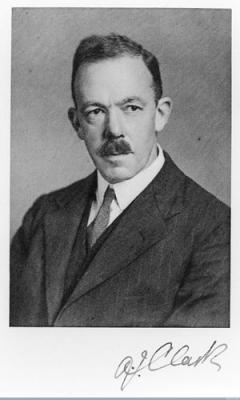Who was Prof Alfred Joseph Clark?
Professor Clark was the 7th person to occupy the Chair of Pharmacology (Materia Medica) at the University from 1926-1942.

The work of Langley, Hill, Erlich and Dale laid the foundations for the birth of the modern discipline of pharmacology during the first decade of the 20th century.
Thereafter the subject stood still, that is until 1926 when A.J. Clark published his now classical papers on the actions of acetylcholine and atropine on the heart. Clark was the first to introduce the log concentration-effect curve, which has become an icon of pharmacology; and the current BPS logo. Clark made the bold step of relating the hyperbolic shape of the stimulus-response curve of drugs to the equilibrium binding equation. He concluded: ‘‘The hypothesis that the concentration-action curve of acetylcholine expresses an adsorption process of the type described by Langmuir appears to involve fewer improbable assumptions than any alternative hypothesis’’ – ie, neurotransmitters, hormones and drugs interact with receptors.
Clark provided the first quantitative study of the antagonism of acetylcholine by atropine and described the now familiar ‘parallel shift’ of the log concentration-response curve produced by a competitive antagonist. He and several of his contemporaries also sought to estimate ligand uptake by organs using methods that represented the forerunner of radio-ligand binding assays, which revolutionized investigations on the selectivity of drug-receptor interactions in the 1980s. Clark calculated, by his relatively imprecise method, that the amount of acetylcholine taken up by the frog heart in producing a 50% maximal effect was sufficient to cover only a small fraction (<1%) of the membrane surface area.
It was from this point forward that the receptor concept began to take hold.
Related Links:
Prof Alfred J Clark's entry in the BPS Hall of Fame

